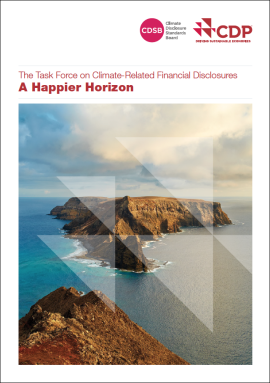At the start of New York Climate Week 2016, CDSB and CDP reflect on the Task Force for Climate related Financial Disclosures and the role of the reporting community in supporting the successful implementation of their recommendations.

In his pivotal speech heralding the formation of the TCFD, Governor Carney indicated that the Task Force’s recommendations would be instrumental in navigating the economy and society away from a tragic horizon dominated by the effects of potentially dangerous climate change.
Climate week 2016 sees just three months to go until the Task Force publishes its recommendations in December. The Phase 1 report confirms that the Task Force will focus on recommendations that relate to disclosure in firms’ mainstream financial filings. This short paper considers what this might mean and how the reporting community could work together to support the successful implementation of climate-related financial disclosure through mainstream reporting channels.
CDSB and CDP propose three practical steps that the reporting community, including NGOs, standard setters, framework developers etc, could do to support the TCFD’s aim to get climate disclosures into the mainstream report.
1. Prepare reporting infrastructure
In order to support successful implementation of the Task Force’s recommendations, the reporting community could work on a practical set of recommendations designed to help companies with the process of gathering and organizing information in preparation for mainstream reporting. Although there is no indication that climate related-financial disclosures recommended by the Task Force will need to be assured, by being presented in the mainstream report, they will at least be read by the financial statement auditor and more sophisticated infrastructure will be required to pave the way for assurance.
2. Practical integration of climate change information into mainstream reports
The reporting community could work on practical guidance to show how climate change related financial information could best be incorporated into mainstream reports. Sustainability practitioners who are likely to be involved in the reporting process might not be familiar with the structure, rationale and expectations of the mainstream report, nor where or how information should be presented. The development of templates by the reporting community could prove particularly helpful. The mainstream reporting model (without climate disclosures) is already under review4 in many jurisdictions. The reporting community will therefore need to think about how best to incorporate climate information into a moving target.
3. Materiality
The Phase 1 report says that this category of information should be reported on where it has attracted investor or market attention if only to explain that the company has considered the risk and not just ignored or overlooked it. The reporting community can help drive this forward by developing guidance that helps companies to distinguish between reporting content that is material to the performance and prospects of the reporting company (i.e.: entity-specific information); and reporting content that is material at aggregate/system wide level.
In conclusion the paper identifies that there is a crucial role for the reporting community to play to ensure the success of the TCFD’s recommendations and create a reporting landscape where decision-useful information is disclosed through the mainstream report. CDP has been working on creating the infrastructure needed for reporting, while CDSB has been developing a community of best practice in mainstream reporting to lead to common practice. Other members of this community have been equally instrumental in the evolution of reporting and as a result, many of the building blocks needed to support the implementation of the TCFD’s recommendations have been created. As actors that collectively influence mainstream reporting, we must work together towards a happier horizon.
To read the full paper click here.
